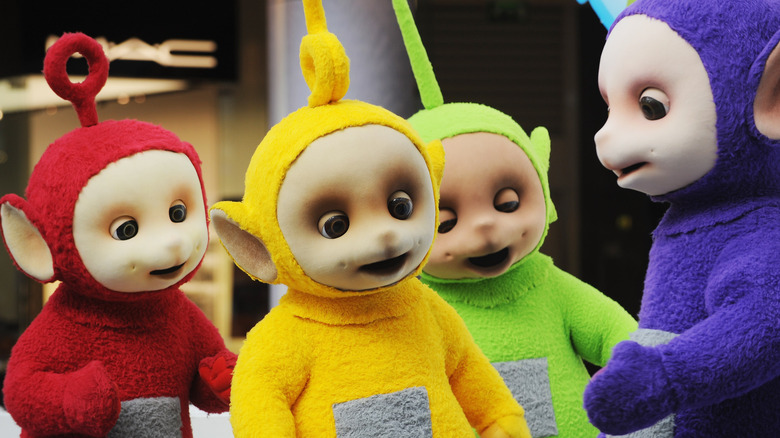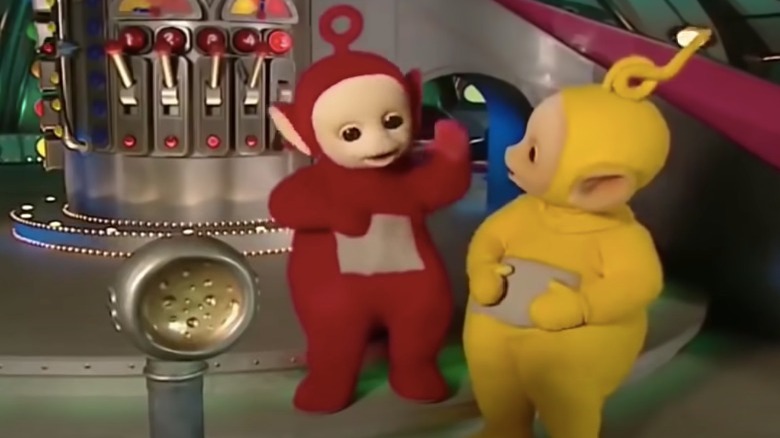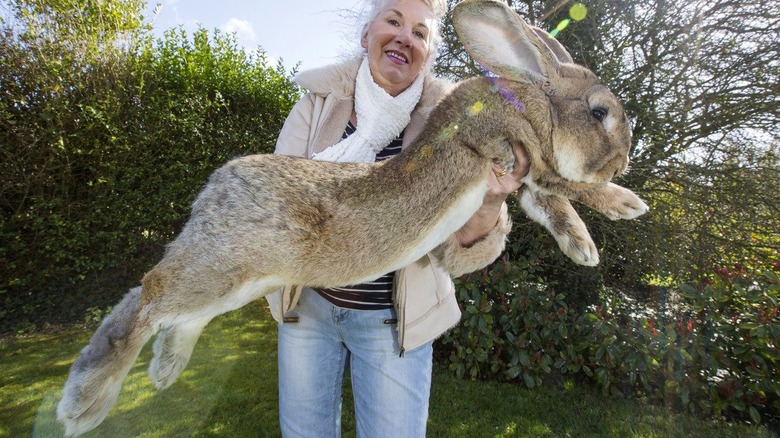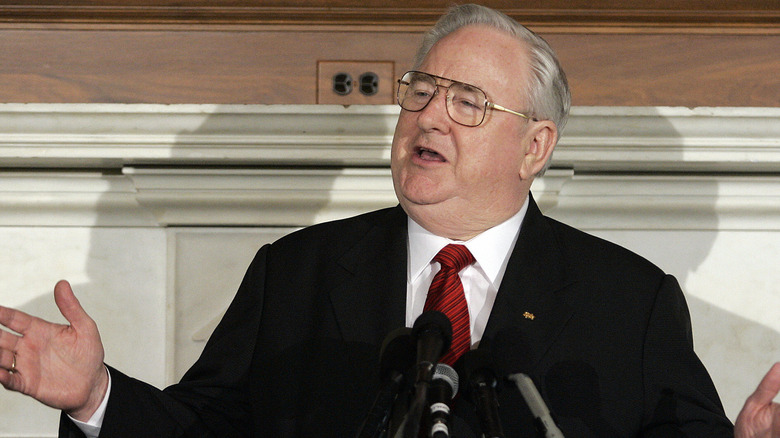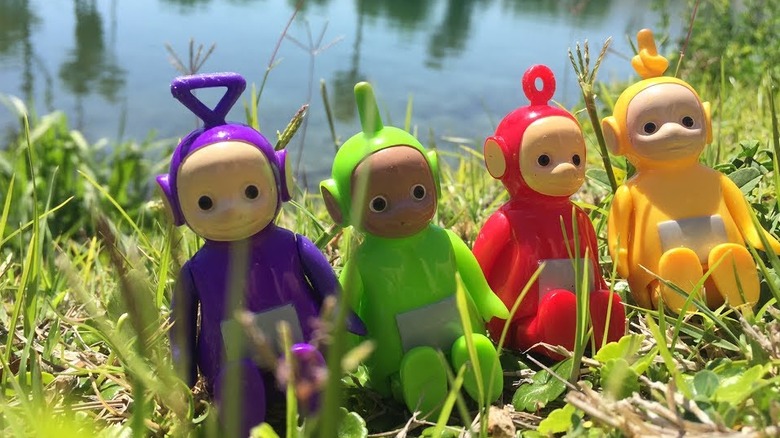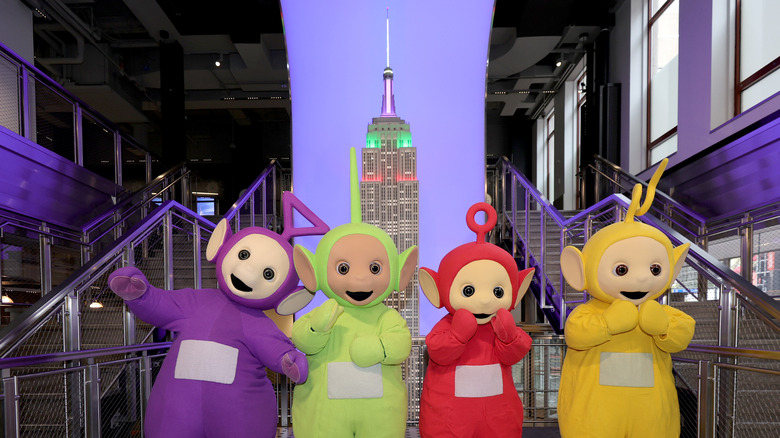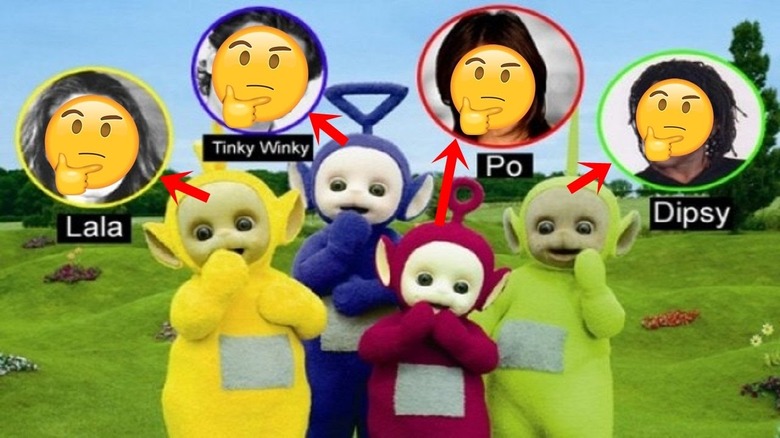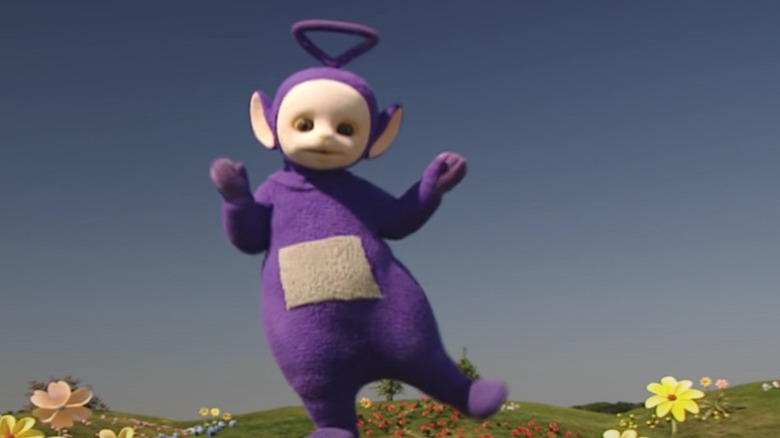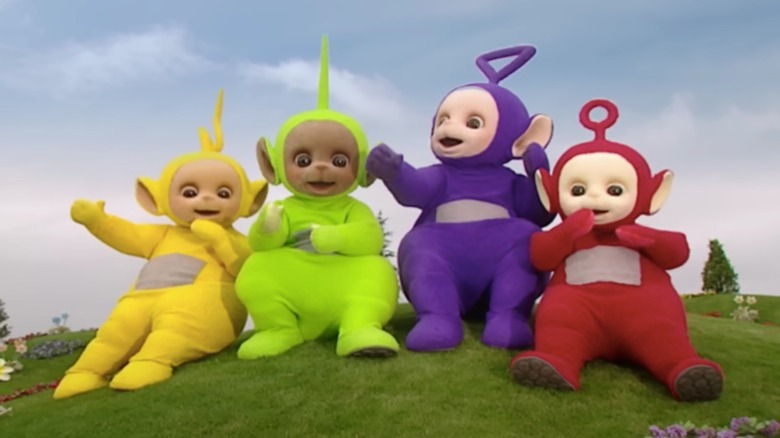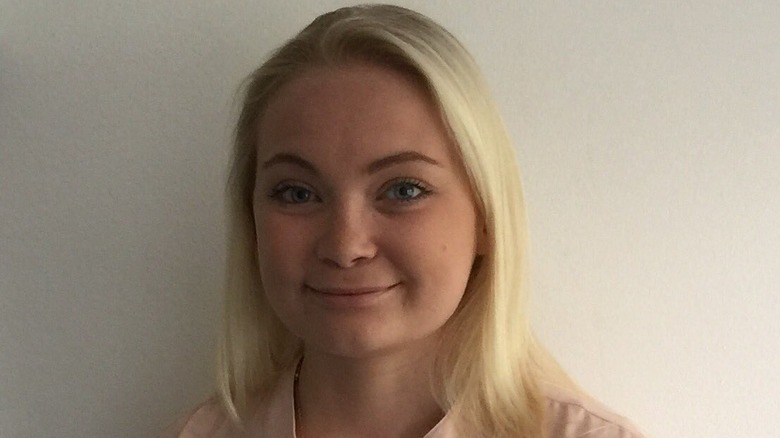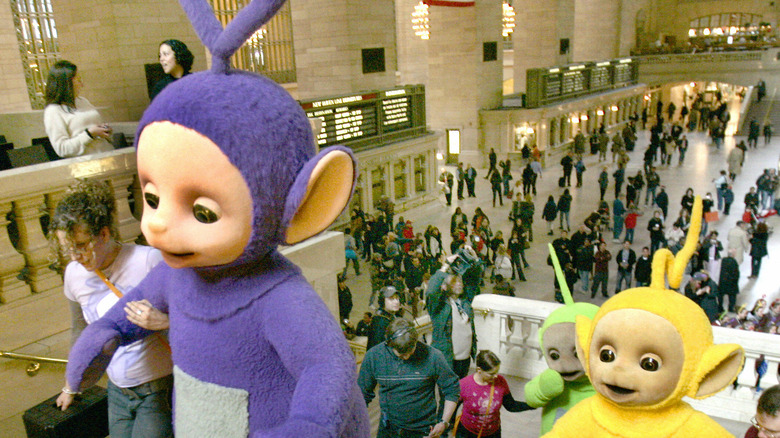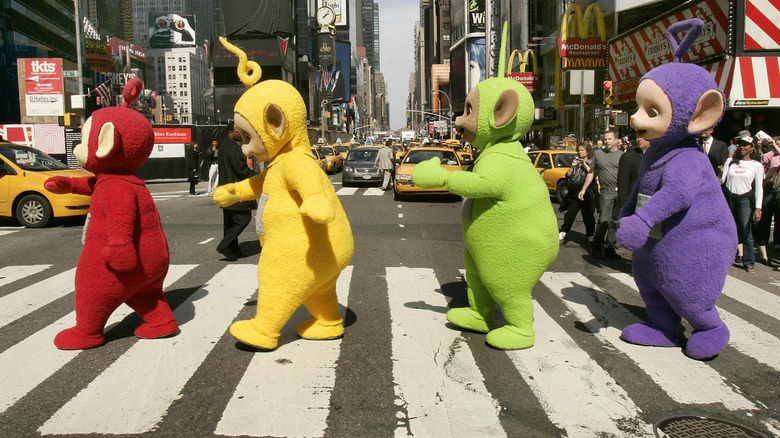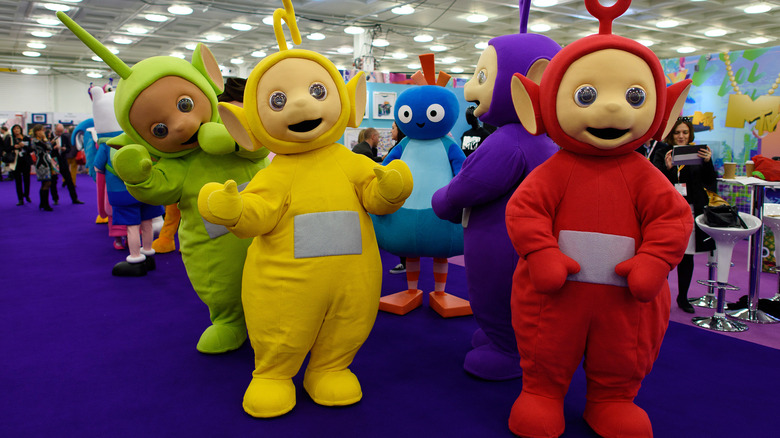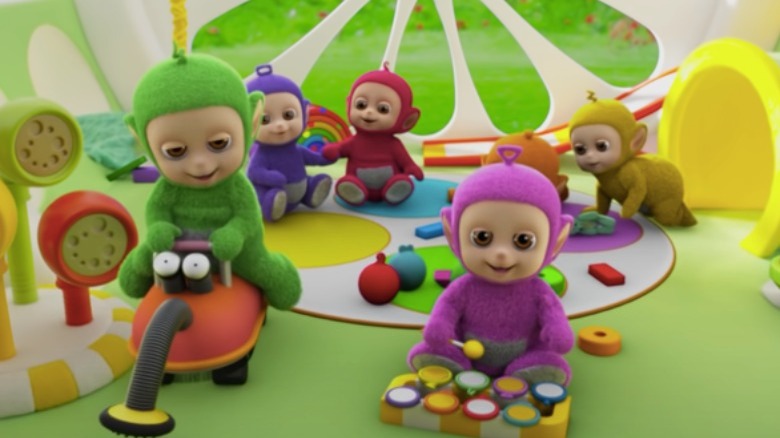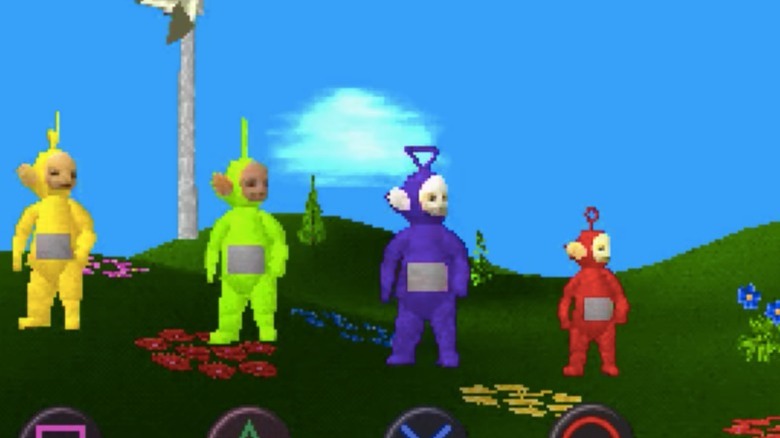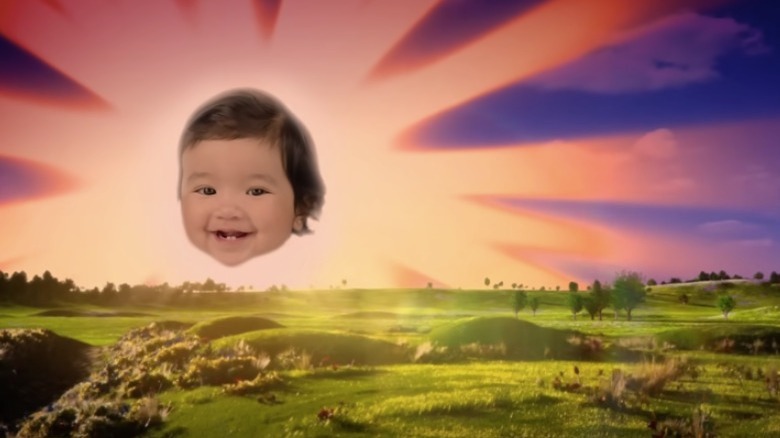Teletubbies: A Look Inside The Polarizing Children's Show
We may receive a commission on purchases made from links.
In the annals of children's television, few programs — or at least few highly successful programs — have been more delightfully surreal than "Teletubbies." Featuring a cast of what look like mutant baby aliens in vividly colored snowsuits, the show was specifically designed to appeal to young children who hadn't yet intellectualized the process of learning. With its psychedelically pastoral sets and use of gibberish as a language, the show promoted non-linear creative development, meeting its target audience right at its own level.
Because of their weirdness, the Teletubbies tended to polarize audiences. Some people were entranced with their whimsical abstraction and bouncing ebullience. Some critics thought they resembled the murdering mutant children in David Cronenberg's horror classic "The Brood." Other parents were disturbed by their eccentricities, and by the television sets embedded into their chests. And some physicians, clearly way ahead of the screen age, even worried that said televisions might be encouraging unhealthy "TV attachments."
But there has really never been anything like Teletubbyland and its irresistible inhabitants. Read on for some little-known trivia about the show The Telegraph once (affectionately) called "surreal ... and sinister."
Teletubbies was created to be the opposite of Power Rangers
"Teletubbies" was created at a time when popular kids' shows such as "Power Rangers" depicted themes of violence and conquest. Creative director of Ragdoll Productions Anne Wood and Andre Davenport, who would end up creating "Teletubbies" together, first saw the "Power Rangers" series while on a flight. It was then that Wood realized she wanted to produce a show that acted as a counterbalance to the "Power Rangers" by promoting more compassionate messages.
In an interview for BBC Two's "Big Hug: The Story of the Teletubbies" documentary, which aired on Christmas Day 1998, Anne Wood revealed her motivation for the series: "I wanted to make a programme that had the direct opposite message — that 'big hug' was the event of the day, and loving each other very much mattered," she said. And that is just what Wood and Davenport ended up doing.
There was a little problem with rabbits dying (and reproducing) on set
Teletubbyland is notable for the giant rabbits that populate it. In real life, however, the winsome creatures' Easter-bunny-perfect lives were somewhat more harrowing.
As "Teletubbies" writer and co-creator Andrew Davenport remembered it, the rabbits "needed to be big to fit in with the scale, and the only suitable ones we could find had been bred on the continent to be eaten — their breeding had given them enlarged hearts, and almost weekly the animal trainer would greet me in distress and tell me another had died. We lost seven out of 11. At least they died happy," Davenport said.
The bunnies also apparently died happy after having a lot of adult rabbit fun on the set (as rabbits are so inclined), which sometimes made filming the show rather ... awkward for all involved. Any footage not appropriate for children was, of course, cut.
A Teletubbies episode was banned in multiple countries
The 11th "Teletubbies" episode "See-Saw Margery Daw," which aired on April 14, 1997, provoked shock and furor in audiences around the world. The episode features child-friendly sketches of British Jazz band King Pleasure and the Biscuit Boys performing a rendition of the episode's titular song and the Teletubbies first performing the "Walking Dance," which would be recreated in later episodes.
However, the episode is best remembered for its hypnotic and disturbing Lion and Bear sketch involving a singing, googly-eyed lion and bear playing hide and seek in a darkened Teletubbyland landscape supported by a menacing score.
According to the Mirror, this particular sketch was considered inappropriate for children and had to be censored by the BBC. Networks in other countries, including PBS in the United States, went a step further and banned the episode from airing outright. The show's creators did rerelease the sketch with more toned-down and light-hearted material.
Jerry Falwell criticized one Teletubby
A lot of things that are weird, wonderful, and original have traditionally been condemned for being "subversive," and "Teletubbies" was no exception. In 1999, televangelist Jerry Falwell made headlines when he claimed that one Teletubby, the purple Tinky Winky, was probably gay.
"He is purple — the gay pride color, and his antenna is shaped like a triangle—the gay pride symbol," a shaken-up Falwell wrote at the time. He also voiced his distress about the bright red purse that the character routinely carried around, despite the fact that he had "a boy's voice."
Falwell would reiterate his "concerns" on the "Today" show, telling Katie Couric that the idea of "little boys running around with purses and acting effeminate ... and gay" was something "Christians do not agree with." Fortunately, said homophobia was dismissed by some Teletubbies themselves as the nonsense that it was. As Tinky Winky, Simon Shelton, himself put it, "People always ask me if Tinky-Winky is gay. But the character is supposed to be a three-year-old, so the question is really quite silly."
What is Tubby Custard, anyway?
One of the most iconic symbols in the "Teletubbies" program is the pink custard dubbed "Tubby Custard," which is made from the Tubby Custard Machine. A problematic situation that recurs throughout the show's history is the Tubby Custard Machine creating an oversupply of the delicacy, thereby creating a mess for the characters.
While the pink Teletubby food may look appetizing to kids, in reality, this "custard" was far from tasty — or even edible — at first. "I'm sorry to disappoint, but it was definitely not fit for human consumption," John Simmit, who played Dipsy, admitted to HuffPost UK. "Later on, they did actually make an edible version, but originally, it was made from mashed potato and acrylic paint and there was a tube going into our costume mouths and siphoned off somewhere else." Fans, however, have long created imitations that are perfectly appropriate as a dessert.
The real-life owner of Teletubbyland flooded her own property to deter tourists
"Teletubbies" was an undeniable hit. So much so, in fact, that the owner of the house and land where the series was filmed (in Wimpstone, Warwickshire, U.K.) couldn't take the influx of tourists coming to gawk at her property.
As Metro explains it, farmer and landowner Rosemary Harding, then 63, decided to take crowd control into her own hands. In 2013, she flooded out a large section of her property on purpose. Meaning that she turned part of her land into a pond. And created, in effect, a type of castle moat that tourists could not get across without going to a lot of trouble. "People were jumping fences and crossing cattle fields," Harding explained to the press.
Ah well, all's well that floods well. For five years (from 1997 to 2001) Harding's land had been overrun with Teletubbies-mania, so it kind of makes sense that the land, and its owner, would be thirsty for something new.
Former New York Mayor Mike Bloomberg started Teletubbies Day
To mark the show's 10th anniversary in 2007, then-New York City Mayor Mike Bloomberg welcomed the fab four and handed the keys to the city in a special ceremony, as reported by New York Magazine. At that point, the franchise had 1 billion viewers worldwide and generated hundreds of millions in merchandise sales, cementing it as a cultural landmark of the era. Before the commemorative ceremony, the costumed stars visited New York's most famous sights, including the Empire State Building, Grand Central Station, and the Statue of Liberty.
The ceremony on March 28 was important as Bloomberg officially declared the date as "Teletubbies Day," but also because it would become the first time the actors who starred as the four characters were unveiled. Producer Anne Wood had diligently ensured the actors' identities had remained unknown until this point but approved their disclosure during the ceremony. The cast members were revealed to be Simon Shelton as Tinky Winky, John Simmit as Dipsy, Nicky Smedley as Laa Laa, and Pui Fan Lee as Po.
The real-life cast of Teletubbies was incredibly diverse
Because "Teletubbies" is so delightfully strange, many people get caught up in its imagery and neglect to note that the show is also a great proponent of racial diversity, and diversity in general.
The original cast was interviewed on the TV show "Behind the Scenes: How Does it Work?" Po, the red Teletubby, was played by actress Pui Fan Lee, who is Cantonese and can speak Cantonese and English. Green Dipsy was played by African-American stand-up comic John Simmit. Bright yellow Teletubby Laa Laa was depicted by Nickey Smedley, an English choreographer and dancer, and Tinky Winky was predominantly played by Simon Shelton, an English ballet dancer.
In the interview, Pui Fan Lee recalls seeing journalists hidden "in the bushes, just trying to find any bit of dirt on the Teletubbies, but in ten years, they didn't even scratch the surface." Which is more than can be said of Pee Wee Herman of Pee Wee's Playhouse, yes?
The first Tinky Winky was let go
You would never have guessed it, but there was a major cast change in the early days of "Teletubbies." Having worked on 70 previous episodes, Dave Thompson, who voiced the predominantly purple Teletubby Tinky Winky, received a letter from one of the show's accountants saying his "interpretation of the role was not acceptable," as he revealed to the Independent. "I wasn't given any clues as to what I was doing wrong," Thompson claimed at the time. Looking back, he suspects his voicework may have been a material factor.
"The other Teletubbies use their own voices, but mine was dubbed over," he said. Despite this disappointment, Thompson went on to work with famous comedian Harry Hill on his self-titled TV series as well as many of his other projects. Thompson was soon replaced by Simon Shelton, who appeared on the show from 1997 to 2001. Shelton tragically died in 2018 from alcohol and hypothermia after being found in a well near the Port of Liverpool Building, Liverpool, per Sky News.
Teletubbies changed ownership in 2013
In 2013, Ragdoll Worldwide, which first created the "Teletubbies," was acquired by Canadian firm DHX Media for £17.4 million. The firm, which was later rebranded as WildBrain Ltd., is notable for co-producing animated series such as "Rastamouse," "Transformers: Rescue Bots" and "Kuu Kuu Harajuku."
As part of the commercial deal with BBC Worldwide, former owner of Ragdoll Worldwide, then DHX Media, acquired 365 episodes of the "Teletubbies," 100 episodes of "In the Night Garden," and 52 episodes of "Teletubbies Everywhere," according to The Guardian. Michael Donovan, DHX Media's chief executive, was enthusiastic when commenting on the deal. "As a leading supplier to subscription video-on-demand services worldwide, we are uniquely positioned to continue to develop these evergreen children's properties in exciting new ways," he told The Guardian at the time.
BBC Worldwide retained the broadcast rights for the "Teletubbies" and Anne Wood and her son Christopher continued managing and operating Ragdoll Productions. After being dormant for 13 years, when the original series ended in 2001, the series was rebooted in 2014 and lasted until 2018, having aired over 100 episodes.
In 2014, the identity of the famous Sun Baby was revealed
Teletubby world is presided over by a smiling and cooing sun baby (whose face, for the uninitiated, actually appears as, and in, the center of the sun). For years, nobody thought much about the identity of the real life tot. The baby was simply an adorable presence beaming and gurgling over a happy land.
In 2014, however, the original Sun Baby was revealed to have been one Jessica (Jess) Smith, then 19 years old, a college student who was only 9 months old when she was selected to portray the merry solar infant in March of 1997.
Jess ended up filming 365 episodes of the original series. And her decision to out herself was rather impromptu. According to The Telegraph, new students at Canterbury Christ Church University were asked to "say something about themselves that no one else would guess." And Jess's revelation must have certainly been the most talked-about disclosure of the entire event.
Teletubbies are actually pretty much giants
As the famous saying goes, the camera adds ten pounds. It also tends to add significant height — many people are shocked at how short some actors actually are when they meet them in real life. Though, the opposite appears to be true for the Teletubbies thanks to the magic of television.
According to Time magazine, though the Tubbies appear to be "a baby-friendly size," they are actually "gargantuan" in person. Even more so than their famous peer, the lumbering Barney the purple dinosaur, himself. And even, for that matter, more so than Big Bird.
All of this is no small feat, for a cast that somehow manages to appear miniature. The smallest Teletubby, Po, is actually 6 feet, 6 inches tall, while the purple, red purse-toting Tinky Winky looms at about 10 feet. As one might imagine, this does indeed make for a cumbersome costume — which stands in stark contrast to what appears to be the Tubbies' airy weightlessness.
Thought they were supposed to be aliens? Us too. And we're all wrong.
When most people see the Teletubbies and their colorful antennas and giggly spaciness, they automatically think "happy alien." However, the characters were, in fact, modeled after astronauts. In an interview for BBC Two's "Big Hug: The Story of the Teletubbies" documentary, Davenport explained the juxtaposition between the technological marvel of interstellar travel and the childlike wonder of exploring the moon. "There's all this high technology involved inputting a spaceman inside a space suit, and sending him up into space and landing him on the moon and it's the most advanced technological thing that ever happens," she said. "And then when they climb out they look like toddlers toddling around a new world for the first time."
Wood and Davenport were also directly ahead of their time, as far as encroaching-technology-as-inspiration went. "We were interested in how children were reacting to the increasingly technological environment of the late 1990s," Wood recalled. And the Teletubbies got TV sets in their tummies as a result. But it all started with the moon landings, and the hoppy bounciness of the astronauts so famously chronicled in that footage eventually became the floaty giddiness of the Teletubbies themselves.
The show was almost syndicated in North Korea
North Korea, the world's most enigmatic "hermit kingdom," has long been a source of distress and speculation for those not living under hereditary dictatorships. Nevertheless, western pop culture's influence is ubiquitous, and at one point, the BBC seriously considered syndicating the show in North Korea.
According to Business Insider, Kim Jong-un spent a substantial part of his childhood in Europe, and was subsequently exposed to influences like Disney, etc. He was said to have taken a particular fancy to Goofy, so the network was led to wonder about the viability of the "Teletubbies" on North Korean shores.
Irish MP Jim Shannon mused that "Teletubbies" could potentially "open up life for millions of people in [North Korea"]. In the end, however, Jong-un wasn't interested in opening up life so much as he was in gleefully watching Disney films and ordering executions, presumably not simultaneously, but who knows.
They had babies?
In the first season of the "Teletubies" reboot, an episode titled "Babies" aired, introducing viewers to eight baby Teletubbies known as Tiddlytubbies: Ping, Duggle Dee, Ru-Ru, Umby Pumby, Daa-Daa, Mi-Mi, Baa, and Nin. Teletubbies with child? How could it be? It was an idea that confused many fans, even though Tiddlytubbies could, theoretically, have come from anywhere — including the stork or the Sun Baby. It's probably best to assume that the Teletubbies did not, in fact, procreate. They likely just beamed down or sprouted up with the flowers — that's what we're going to believe anyway.
The adorable tiny characters live in the Tubbytronic Superdome along with their older counterparts. They spend most of their time recreationally in their play area, where a number of toys can be found such as the Tiddlynoo, Bouncy Swing, and Umby Pumby's Teddy Bear. The Teletubbies and Tiddlytubbies often interact during playtime, which is announced via voice trumpet playing a tune and declaring "Time for Tiddlytubbies, Tiddlytubbies playtime!"
While their voices may all sound different, all of the Tiddlytubbies are, as it turns out, voiced by one person: British-American Teresa Gallagher, who also worked on the "Amazing World of Gumball" and "Octonauts: Above & Beyond."
There was a Teletubbies video game
"Teletubbies" merch — which ranged from toothbrushes to pajamas to kitchen playsets – was a huge commercial success. Additionally, the Teletubbies even had a U.K. No. 1 single for two weeks with "Teletubbies say Eh-oh!" that went on to achieve double platinum status.
The franchise even expanded into the video game universe in the form of an educational video game "Play with the Teletubbies," which was developed by Asylum Entertainment and first released for Microsoft Windows in 1998 before being released on the Playstation 1 in 1999. This game received pretty positive reviews overall. As one reviewer wrote, "This is a game which will keep kids occupied for hours, especially the little ones who love the show so much."
In December 2017, DHX Media announced the launch of the mobile game "Teletubbies Play Time," which was released for Android and iOS devices. Developed by Built Games, the game developer's CEO Mike Pagano commented on the game to Wildbrain. "To be able to watch a child smile as they interact with 'Teletubbies Play Time' sounding out, for example, a word that Laa-Laa asks them to repeat, is one of the most rewarding experiences I've ever had," he said.
The Teletubbies was rebooted again in 2022
After a four-year hiatus, Netflix announced the second reboot of the "Teletubbies," which is slated to premiere on November 14, 2022, The Hollywood Reporter revealed. The show will be narrated by "Unbreakable Kimmy Schmidt" star Tituss Burgess. The first season will consist of 26 episodes lasting 12 minutes each (via Deadline). The show is one of several upcoming Netflix productions geared for preschool children such as "Spirit Rangers," "Princess Power," and "Cocomelon." In keeping with the entertainment industry's efforts to diversify casts and storylines, the trailer for the upcoming series features the first non-white Sun Baby who will open the iconic show.
"Teletubbies" began as a quirky and novel children's show but rapidly became a global phenomenon watched and adored by millions. Fans, new and old, are undoubtedly eagerly anticipating the upcoming Netflix reboot, which aims to once again capture the imaginations of its audience.
